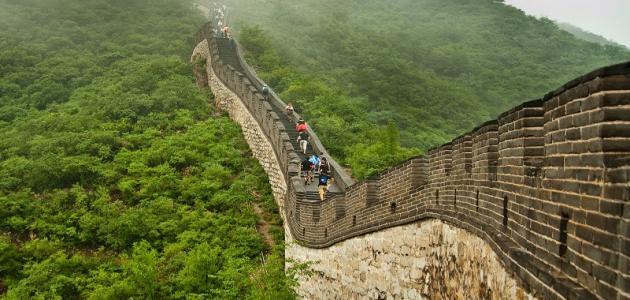The Great Wall of China is a vast fortress erected in ancient China, one of the largest buildings – construction projects ever undertaken. The Great Wall actually consists of many walls – many of them parallel to each other – that were built over two thousand years across northern China and southern Mongolia.
Kiev. Ukraine. Ukraine Gate – March 30, 2021 – Tourism and Travel
The most comprehensive and best-preserved wall dates back to the Ming Dynasty and extends for 5,500 miles (8,850 km) from east to west is near Dandong, southeast of Liaoning Province, to the Jiayu Corridor west of Jiuquan in northwestern Gansu Province. This wall often traces the lines of hilltops and mountains as it flows through snakes across the Chinese countryside, and only a quarter of its length is made up of natural barriers such as rivers and mountain ridges. Almost all of the remainder (about 70 percent of the total length) is an actual erected wall, with the small extensions remaining forming trenches.
Although long sections of the wall are now in ruins or completely gone, it remains one of the most remarkable structures on Earth. The Great Wall of China is listed on the UNESCO World Heritage List.
The history of the fortification system dates from the seventh to the fourth century BC. In the century BC Shihuangdi (Qin Shi Huang), the first emperor of a united China (under the Qin dynasty).
The wall’s eastern terminus was considered the Shanhai (Shanhaiguan) corridor in eastern Hebei province along the coast of Bo Hai (the Gulf of Chile), and the length of the wall – without its branches and other minor sections – was thought to extend for about 4,160 miles (6,700 km). However, government-sponsored investigations that began in the 1990s uncovered parts of the wall in Liaoning, and air and satellite surveillance finally established that this wall had consistently extended across most of the province. The greater overall length of the Ming Wall has been announced.
The Great Wall evolved from the disparate frontier fortifications and fortresses of individual Chinese kingdoms for centuries. These kingdoms may have been interested in protection from their close neighbors as much as they were concerned with the risk of barbarian invasions or raids.
Around the 7th century BC, the Chu nation began building a permanent defense system. This fort, known as the “Square Wall,” was located in the northern part of the Kingdom’s Capital District. From the sixth to the fourth century other states followed the example of Chu. In the southern part of Chi Prefecture, an extensive ocean wall was gradually established using existing river embankments, a newly constructed fort, and impassable mountainous terrain areas. The Qi Wall was mainly built of earth and stone and finished at the shores of the Yellow Sea.
In Zhongshan Prefecture, a wall system was built to thwart the invasion of the Zhao Qin States in the southwest. There were two lines of defense in Wai Prefecture: the Hexi Wall (“west of the [yellow] river) and the walls of Henan (“ south of the river ”). The Hexi Wall was a bulwark against the Qin state and the western nomads, constructed during the reign of King Hui, and was enlarged from the levees on the Lu River on the western border.
It began in the south near Xiangyuan Cave, east of Mount Hua, and ended in Guyang in what is now the Inner Mongolia Autonomous Region. The Henan Wall was built to protect Daliang (now the capital of Kaifeng), and was restored and expanded in the later years of King Hui. The state of Cheng also built a wall system that the Han rebuilt the state after it invaded Cheng. The Zhao State completed a Southern Wall and a Northern Wall, and the Southern Wall was mainly built to defend against the Wai State.
After the conduct of administrative reorganization by Shang Yang, the state of Qin grew politically and militarily to become the most powerful among the seven states but was frequently attacked by Dongo and Luvan, two nomadic peoples of the north. Therefore, Qin erected a wall that started from Lintiao, and northward along the Liupan Mountains and ended at Huang He (Yellow River).
In Yan State, two separate defensive lines – the North Wall and the Roasting Wall – were set up in an effort to defend the kingdom from attacks by northern groups such as Donghu, Linhu, and Loufan, as well as by the Qi State in the South. The Yishui Wall was expanded from the Yi River Dam as a line of defense against Qi and Zhao, the two main rival nations. It began southwest of Yi City, the capital, and ended south of Wen’an. In 290 BC, the state of Yan built the northern wall along the Yan Mountains, starting from the northeast in Zhangjiakou District in Hebei, passing through the Liao River, and extending into the ancient city of Xiangping, this was the last part of the Great Wall that was constructed during Zhanguo (Warring States) period.
In 221 BC Shihuangdi, the first Qin emperor, completed the annexation of Qi and thus the unification of China. He ordered the removal of the fortifications that had been erected between the former states because they acted as obstacles to internal movements and the administration. In addition, General Meng Tian was sent to protect the northern border against the incursions of the nomadic Xiongnu and linked the wall sections in Qin, Yan and Zhao with the soled “Long Wall 10,000 Li” (2 Li equals approximately 0.6 miles [1 km]).
This period of construction began around 214 BC and lasted a decade. Hundreds of thousands of soldiers and conscripts worked on the project. With the fall of the Qin dynasty after the death of the Shihuangdi, the wall was left largely unguarded and fell into disrepair.
Read also: A New Way of Local State Administrations Work
Source: Ukrgate







